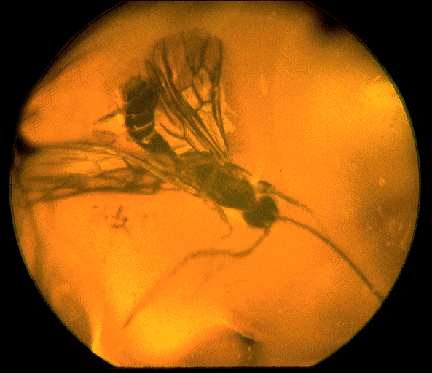

Thirty million years ago this wasp found itself stuck to a drop of tree sap. Unable to free itself, it was eventually covered with more sap, which petrified over the ages.The wasp is only about a quarter of an inch long or so; I took this picture through a microscope. But the details of the specimen are preserved with such perfection that I get sick with amazement every time I look at it. It's like tuning in to an ultra-high-resolution time machine and staring directly at a creature that hasn't existed for millions of years. The specimen is definitely an insect in the order hymenoptera, not the more common diptera (in other words, it's a wasp, not a fly). You can tell because if you examine it closely there are four wings; all flies have only two wings. It appears to have a well-developed ovipositor (stinger), but it is not hairy as a bee would be, and it seems to lack a dorsal hump in the first abdominal segment, so it's not a flying ant. It does have the constricted abdomen, so it may be in the suborder apocrita: a parasitic wasp.
I have no idea if the suborders were the same in the Eocene or Miocene, which is the age of this specimen. All the identifying data in the above paragraph came from A Field Guide to the Insects from the Peterson Field Guide Series, and the authors of that book probably weren't concerned with 30 million year-old taxonomy. But such exquisite detail is visible here, that, if a field guide existed, I believe I could identify this critter with fairly good precision. One usually looks at the venation in the wings to determine the genus and (with luck) species of a wasp. And the venation here is plenty clear, as you can see.
The amber is a pebble that was mined the Dominican Republic. I bought it (pre-Jurassic Park ) at Harvard University's Museum of Comparative Zoology gift shop.
